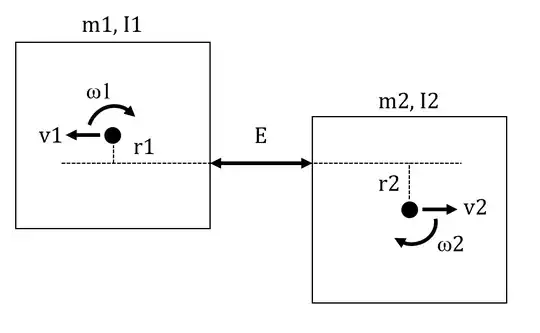I am writing a simple physics simulation of a real-life problem, and am having trouble coming up with a closed-form solution.
Problem description
Two rigid bodies with specified masses $m_1$, $m_2$ and moments of inertia $I_1$, $I_2$ are tied together and compress a spring with stored energy $E$. These bodies are initially at rest and lying on a frictionless surface. At a certain time, the line connecting the bodies is cut, and the spring pushes the two bodies apart such that they slide and rotate on the surface. Note that the spring is not permanently attached, so there is no restoring force.
If the spring acts along a line of action with orthogonal distances $r_1$, $r_2$ to each body’s center of mass, then find the resulting velocities $v_1$, $v_2$ and rates of rotation $ω_1$, $ω_2$ for each body.
Here is a top view of this setup:
Current approach
This is essentially equivalent to an super-elastic collision problem, with a non-zero energy loss (gain) at the moment of impact. However, I cannot find example of this problem where one of the bodies is not a ball or point mass (which results in one known $ω = 0$, making for three unknowns).
In this case, I have four unknowns: $v_1$, $v_2$, $ω_1$, $ω_2$. I currently have three constraining equations: energy conservation, angular momentum conservation, and linear momentum conservation:
$$E = \frac{1}{2}m_1v_1^2 + \frac{1}{2}m_2v_2^2 + \frac{1}{2}I_1ω_1^2 + \frac{1}{2}I_2ω_2^2,$$ $$L = 0 = m_1v_1r_1 + m_2v_2r_2 + I_1ω_1 + I_2ω_2,$$ $$P = 0 = m_1v_1 + m_2v_2.$$
However, I’m lost as to finding a fourth constraining equation. This seems to me like it should have a closed form solution, does it?
